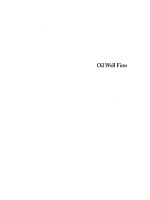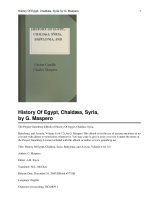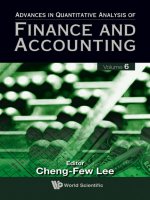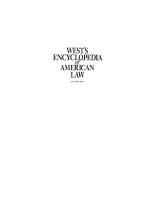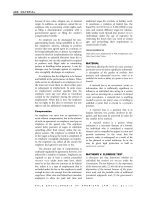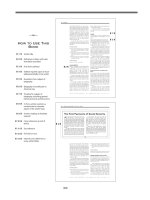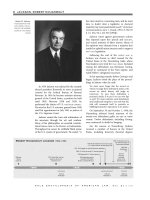CFA Curriculum Volume 6 2022
Bạn đang xem bản rút gọn của tài liệu. Xem và tải ngay bản đầy đủ của tài liệu tại đây (6.34 MB, 555 trang )
© CFA Institute. For candidate use only. Not for distribution.
PORTFOLIO
MANAGEMENT
AND ETHICAL AND
PROFESSIONAL
STANDARDS
CFAđ Program Curriculum
2022 ã LEVEL I ã VOLUME 6
© CFA Institute. For candidate use only. Not for distribution.
© 2021, 2020, 2019, 2018, 2017, 2016, 2015, 2014, 2013, 2012, 2011, 2010, 2009, 2008,
2007, 2006 by CFA Institute. All rights reserved.
This copyright covers material written expressly for this volume by the editor/s as well
as the compilation itself. It does not cover the individual selections herein that first
appeared elsewhere. Permission to reprint these has been obtained by CFA Institute
for this edition only. Further reproductions by any means, electronic or mechanical,
including photocopying and recording, or by any information storage or retrieval
systems, must be arranged with the individual copyright holders noted.
CFA®, Chartered Financial Analyst®, AIMR-PPS®, and GIPS® are just a few of the trademarks owned by CFA Institute. To view a list of CFA Institute trademarks and the
Guide for Use of CFA Institute Marks, please visit our website at www.cfainstitute.org.
This publication is designed to provide accurate and authoritative information in regard
to the subject matter covered. It is sold with the understanding that the publisher
is not engaged in rendering legal, accounting, or other professional service. If legal
advice or other expert assistance is required, the services of a competent professional
should be sought.
All trademarks, service marks, registered trademarks, and registered service marks
are the property of their respective owners and are used herein for identification
purposes only.
ISBN 978-1-950157-47-1 (paper)
ISBN 978-1-950157-71-6 (ebk)
10 9 8 7 6 5 4 3 2 1
© CFA Institute. For candidate use only. Not for distribution.
CONTENTS
How to Use the CFA Program Curriculum
Background on the CBOK
Organization of the Curriculum
Features of the Curriculum
Designing Your Personal Study Program
CFA Institute Learning Ecosystem (LES)
Prep Providers
Feedback
xv
xv
xvi
xvi
xvii
xviii
xix
xx
Portfolio Management
Study Session 18
Portfolio Management (2)
3
Reading 51
Basics of Portfolio Planning and Construction
Introduction
Portfolio Planning, the Investment Policy Statement (IPS) and Its Major
Components
The Investment Policy Statement
Major Components of an IPS
IPS Risk and Return Objectives
Return Objectives
IPS Constraints: Liquidity, Time Horizon, Tax Concerns, Legal and
Regulatory Factors, and Unique Circumstances
Liquidity Requirements
Time Horizon
Tax Concerns
Legal and Regulatory Factors
Unique Circumstances and ESG Considerations
Gathering Client Information
Portfolio Construction and Capital Market Expectations
Capital Market Expectations
The Strategic Asset Allocation
Steps Toward an Actual Portfolio and Alternative Portfolio Organizing
Principles
New Developments in Portfolio Management
ESG Considerations in Portfolio Planning and Construction
Summary
Practice Problems
Solutions
5
6
Reading 52
The Behavioral Biases of Individuals
Introduction and Categorizations of Behavioral Biases
Categorizations of Behavioral Biases
Cognitive Errors
Belief Perseverance Biases
indicates an optional segment
6
6
7
8
14
15
16
16
17
18
18
20
23
24
24
32
36
37
40
43
47
49
49
50
50
50
ii
© CFA Institute. For candidate use only. Not for distribution.
Processing Errors
Emotional Biases
Loss-
Aversion Bias
Overconfidence Bias
Self-
Control Bias
Status Quo Bias
Endowment Bias
Regret-
Aversion Bias
How Behavioral Finance Influences Market Behavior
Defining Market Anomalies
Momentum
Bubbles and Crashes
Value
Summary
Practice Problems
Solutions
Reading 53
Reading 54
Contents
56
63
63
65
66
66
67
69
72
72
73
73
75
76
78
81
Introduction to Risk Management
Introduction
The Risk Management Process
The Risk Management Framework
Risk Governance - An Enterprise View
An Enterprise View of Risk Governance
Risk Tolerance
Risk Budgeting
Identification of Risk - Financial and Non-Financial Risk
Financial Risks
Non-
Financial Risks
Identification of Risk - Interactions Between Risks
Measuring and Modifying Risk - Drivers and Metrics
Drivers
Metrics
Methods of Risk Modification - Prevention, Avoidance, and Acceptance
Risk Prevention and Avoidance
Risk Acceptance: Self-Insurance and Diversification
Methods of Risk Modification - Transfer, Shifting, Choosing a Method for
Modifying
Risk Shifting
How to Choose Which Method for Modifying Risk
Summary
Practice Problems
Solutions
83
83
85
87
93
93
96
98
101
101
102
107
110
110
112
116
116
117
Technical Analysis
Introduction
Technical Analysis: Principles, Assumptions, and links to Investment
Analysis
Principles and Assumptions
Technical Analysis and Behavioral Finance
133
133
indicates an optional segment
118
120
122
124
127
130
134
135
136
Contents
© CFA Institute. For candidate use only. Not for distribution.
Technical Analysis and Fundamental Analysis
The Differences in Conducting/Interpreting Technical Analysis in
Various Types of Markets
Chart Types
Types of Technical Analysis Charts
Trend, Support, and Resistance
Common Chart Patterns
Reversal Patterns
Continuation Patterns
Technical Indicators: Moving Averages and Bollinger Bands
Technical Indicators
Technical Indicators: Oscillators, Relative Strength, and Sentiment
Rate of Change Oscillator
Relative Strength Index
Stochastic Oscillator
Moving-Average Convergence/Divergence Oscillator (MACD)
Sentiment Indicators
Intermarket Analysis
Principles of Intermarket Analysis
Technical Analysis Applications to Portfolio Management
The Role of the Technical Analyst in Fundamental Portfolio
Management
Summary
Practice Problems
Solutions
Reading 55
iii
138
139
141
143
153
156
156
166
175
177
181
182
184
186
188
189
195
196
198
210
212
215
221
Fintech in Investment Management
225
Introduction and What is Fintech
225
What Is Fintech?
226
Big Data
227
Sources of Big Data
229
Big Data Challenges
230
Advanced Analytical Tools: Artificial Intelligence and Machine Learning
230
Types of Machine Learning
232
Data Science: Extracting Information from Big Data
233
Data Processing Methods
233
Data Visualization
234
Selected Applications of Fintech to Investment Management; Text
Analytics & Natural Language Processing
236
Text Analytics and Natural Language Processing
236
Robo-
Advisory Services
237
Risk Analysis
239
Algorithmic Trading
240
Distributed Ledger Technology, and Permissioned and Permissionless
Networks
240
Permissioned and Permissionless Networks
243
Applications of Distributed Ledger Technology to Investment Management 243
Cryptocurrencies
243
Tokenization
244
indicates an optional segment
iv
© CFA Institute. For candidate use only. Not for distribution.
Post-Trade Clearing and Settlement
Compliance
Summary
Practice Problems
Solutions
Contents
244
244
245
247
249
Ethical and Professional Standards
Study Session 19
Ethical and Professional Standards
253
Reading 56
Ethics and Trust in the Investment Profession
Introduction
Ethics
Ethics and Professionalism
How Professions Establish Trust
Professions Are Evolving
Professionalism in Investment Management
Trust in Investment Management
CFA Institute as an Investment Management Professional Body
Challenges to Ethical Conduct
Ethical vs. Legal Standards
Ethical Decision-Making Frameworks
The Framework for Ethical Decision-Making
Applying the Framework
Conclusion
Summary
Practice Problems
Solutions
255
255
257
259
260
262
262
263
263
265
267
270
270
272
278
278
281
283
Reading 57
Code of Ethics and Standards of Professional Conduct
Preface
Evolution of the CFA Institute Code of Ethics and Standards of
Professional Conduct
Standards of Practice Handbook
Summary of Changes in the Eleventh Edition
CFA Institute Professional Conduct Program
Adoption of the Code and Standards
Acknowledgments
Ethics and the Investment Industry
Why Ethics Matters
CFA Institute Code of Ethics and Standards of Professional Conduct
Preamble
The Code of Ethics
Standards of Professional Conduct
Practice Problems
Solutions
285
285
indicates an optional segment
286
286
287
289
290
290
291
291
295
295
296
296
300
302
Contents
Reading 58
© CFA Institute. For candidate use only. Not for distribution.
Guidance for Standards I–VII
Standard I(A): Professionalism - Knowledge of the Law
Standard I(A) Knowledge of the Law
Guidance
Standard I(A): Recommended Procedures
Members and Candidates
Distribution Area Laws
Legal Counsel
Dissociation
Firms
Standard I(A): Application of the Standard
Example 1 (Notification of Known Violations):
Example 2 (Dissociating from a Violation):
Example 3 (Dissociating from a Violation):
Example 4 (Following the Highest Requirements):
Example 5 (Following the Highest Requirements):
Example 6 (Laws and Regulations Based on Religious Tenets):
Example 7 (Reporting Potential Unethical Actions):
Example 8 (Failure to Maintain Knowledge of the Law):
Standard I(B): Professionalism - Independence and Objectivity
Guidance
Standard I(B): Recommended Procedures
Standard I(B): Application of the Standard
Example 1 (Travel Expenses):
Example 2 (Research Independence):
Example 3 (Research Independence and Intrafirm Pressure):
Example 4 (Research Independence and Issuer Relationship
Pressure):
Example 5 (Research Independence and Sales Pressure):
Example 6 (Research Independence and Prior Coverage):
Example 7 (Gifts and Entertainment from Related Party):
Example 8 (Gifts and Entertainment from Client):
Example 9 (Travel Expenses from External Manager):
Example 10 (Research Independence and Compensation
Arrangements):
Example 11 (Recommendation Objectivity and Service Fees):
Example 12 (Recommendation Objectivity):
Example 13 (Influencing Manager Selection Decisions):
Example 14 (Influencing Manager Selection Decisions):
Example 15 (Fund Manager Relationships):
Example 16 (Intrafirm Pressure):
Standard I(C): Professionalism – Misrepresentation
Guidance
Standard I(C): Recommended Procedures
Factual Presentations
Qualification Summary
Verify Outside Information
Maintain Webpages
Plagiarism Policy
indicates an optional segment
v
305
305
305
306
310
310
311
311
311
311
312
312
312
312
313
313
313
314
314
315
315
320
322
322
322
322
323
323
323
324
324
325
325
326
326
327
327
327
328
328
328
332
332
333
333
333
333
vi
© CFA Institute. For candidate use only. Not for distribution.
Contents
Standard I(C): Application of the Standard
334
Example 1 (Disclosure of Issuer-Paid Research):
334
Example 2 (Correction of Unintentional Errors):
334
Example 3 (Noncorrection of Known Errors):
334
Example 4 (Plagiarism):
335
Example 5 (Misrepresentation of Information):
335
Example 6 (Potential Information Misrepresentation):
335
Example 7 (Plagiarism):
336
Example 8 (Plagiarism):
336
Example 9 (Plagiarism):
336
Example 10 (Plagiarism):
337
Example 11 (Misrepresentation of Information):
337
Example 12 (Misrepresentation of Information):
337
Example 13 (Avoiding a Misrepresentation):
338
Example 14 (Misrepresenting Composite Construction):
338
Example 15 (Presenting Out-of-Date Information):
339
Example 16 (Overemphasis of Firm Results):
339
Standard I(D): Professionalism – Misconduct
340
Guidance
340
Standard I(D): Recommended Procedures
341
Standard I(D): Application of the Standard
341
Example 1 (Professionalism and Competence):
341
Example 2 (Fraud and Deceit):
341
Example 3 (Fraud and Deceit):
342
Example 4 (Personal Actions and Integrity):
342
Example 5 (Professional Misconduct):
342
Standard II(A): Integrity of Capital Markets - Material Nonpublic Information 343
Standard II(A) Material Nonpublic Information
343
Guidance
343
Standard II(A): Recommended Procedures
347
Achieve Public Dissemination
347
Adopt Compliance Procedures
347
Adopt Disclosure Procedures
348
Issue Press Releases
348
Firewall Elements
348
Appropriate Interdepartmental Communications
348
Physical Separation of Departments
349
Prevention of Personnel Overlap
349
A Reporting System
349
Personal Trading Limitations
350
Record Maintenance
350
Proprietary Trading Procedures
350
Communication to All Employees
350
Standard II(A): Application of the Standard
351
Example 1 (Acting on Nonpublic Information):
351
Example 2 (Controlling Nonpublic Information):
351
Example 3 (Selective Disclosure of Material Information):
352
Example 4 (Determining Materiality):
352
Example 5 (Applying the Mosaic Theory):
352
indicates an optional segment
Contents
© CFA Institute. For candidate use only. Not for distribution.
Example 6 (Applying the Mosaic Theory):
Example 7 (Analyst Recommendations as Material Nonpublic
Information):
Example 8 (Acting on Nonpublic Information):
Example 9 (Mosaic Theory):
Example 10 (Materiality Determination):
Example 11 (Using an Expert Network):
Example 12 (Using an Expert Network):
Standard II(B): Integrity of Capital Markets - Market Manipulation
Guidance
Standard II(B): Application of the Standard
Example 1 (Independent Analysis and Company Promotion):
Example 2 (Personal Trading Practices and Price):
Example 3 (Creating Artificial Price Volatility):
Example 4 (Personal Trading and Volume):
Example 5 (“Pump-Priming” Strategy):
Example 6 (Creating Artificial Price Volatility):
Example 7 (Pump and Dump Strategy):
Example 8 (Manipulating Model Inputs):
Example 9 (Information Manipulation):
Standard III(A): Duties to Clients - Loyalty, Prudence, and Care
Standard III(A) Loyalty, Prudence, and Care
Guidance
Standard III(A): Recommended Procedures
Regular Account Information
Client Approval
Firm Policies
Standard III(A): Application of the Standard
Example 1 (Identifying the Client—Plan Participants):
Example 2 (Client Commission Practices):
Example 3 (Brokerage Arrangements):
Example 4 (Brokerage Arrangements):
Example 5 (Client Commission Practices):
Example 6 (Excessive Trading):
Example 7 (Managing Family Accounts):
Example 8 (Identifying the Client):
Example 9 (Identifying the Client):
Example 10 (Client Loyalty):
Example 11 (Execution-Only Responsibilities):
Standard III(B): Duties to Clients - Fair Dealing
Guidance
Standard III(B): Recommended Procedures
Develop Firm Policies
Disclose Trade Allocation Procedures
Establish Systematic Account Review
Disclose Levels of Service
Standard III(B): Application of the Standard
Example 1 (Selective Disclosure):
Example 2 (Fair Dealing between Funds):
indicates an optional segment
vii
353
353
353
354
354
355
355
355
356
357
357
357
358
358
358
359
360
360
360
361
361
361
365
365
365
365
366
366
367
367
368
368
368
369
369
369
370
370
370
371
373
373
375
375
375
375
375
376
viii
© CFA Institute. For candidate use only. Not for distribution.
Contents
Example 3 (Fair Dealing and IPO Distribution):
Example 4 (Fair Dealing and Transaction Allocation):
Example 5 (Selective Disclosure):
Example 6 (Additional Services for Select Clients):
Example 7 (Minimum Lot Allocations):
Example 8 (Excessive Trading):
Example 9 (Limited Social Media Disclosures):
Example 10 (Fair Dealing between Clients):
Standard III(C): Duties to Clients – Suitability
Guidance
Standard III(C): Recommended Procedures
Investment Policy Statement
Regular Updates
Suitability Test Policies
Standard III(C): Application of the Standard
Example 1 (Investment Suitability—Risk Profile):
Example 2 (Investment Suitability—Entire Portfolio):
Example 3 (IPS Updating):
Example 4 (Following an Investment Mandate):
Example 5 (IPS Requirements and Limitations):
Example 6 (Submanager and IPS Reviews):
Example 7 (Investment Suitability—Risk Profile):
Example 8 (Investment Suitability):
Standard III(D): Duties to Clients - Performance Presentation
Guidance
Standard III(D): Recommended Procedures
Apply the GIPS Standards
Compliance without Applying GIPS Standards
Standard III(D): Application of the Standard
Example 1 (Performance Calculation and Length of Time):
Example 2 (Performance Calculation and Asset Weighting):
Example 3 (Performance Presentation and Prior Fund/Employer):
Example 4 (Performance Presentation and Simulated Results):
Example 5 (Performance Calculation and Selected Accounts Only):
Example 6 (Performance Attribution Changes):
Example 7 (Performance Calculation Methodology Disclosure):
Example 8 (Performance Calculation Methodology Disclosure):
Standard III(E): Duties to Clients - Preservation of Confidentiality
Guidance
Standard III(E): Recommended Procedures
Communicating with Clients
Standard III(E): Application of the Standard
Example 1 (Possessing Confidential Information):
Example 2 (Disclosing Confidential Information):
Example 3 (Disclosing Possible Illegal Activity):
Example 4 (Disclosing Possible Illegal Activity):
Example 5 (Accidental Disclosure of Confidential Information):
Standard IV(A): Duties to Employers – Loyalty
Standard IV(A) Loyalty
indicates an optional segment
376
377
377
377
378
378
378
379
379
380
382
383
383
383
384
384
384
384
385
385
386
386
386
387
387
388
388
388
388
389
389
389
390
390
390
391
391
392
392
393
394
394
394
394
395
395
395
396
396
Contents
© CFA Institute. For candidate use only. Not for distribution.
Guidance
Standard IV(A): Recommended Procedures
Competition Policy
Termination Policy
Incident-
Reporting Procedures
Employee Classification
Standard IV(A): Application of the Standard
Example 1 (Soliciting Former Clients):
Example 2 (Former Employer’s Documents and Files):
Example 3 (Addressing Rumors):
Example 4 (Ownership of Completed Prior Work):
Example 5 (Ownership of Completed Prior Work):
Example 6 (Soliciting Former Clients):
Example 7 (Starting a New Firm):
Example 8 (Competing with Current Employer):
Example 9 (Externally Compensated Assignments):
Example 10 (Soliciting Former Clients):
Example 11 (Whistleblowing Actions):
Example 12 (Soliciting Former Clients):
Example 13 (Notification of Code and Standards):
Example 14 (Leaving an Employer):
Example 15 (Confidential Firm Information):
Standard IV(B): Duties to Employers - Additional Compensation
Arrangements
Guidance
Standard IV(B): Recommended Procedures
Standard IV(B): Application of the Standard
Example 1 (Notification of Client Bonus Compensation):
Example 2 (Notification of Outside Compensation):
Example 3 (Prior Approval for Outside Compensation):
Standard IV(C): Duties to Employers - Responsibilities of Supervisors
Guidance
Standard IV(C): Recommended Procedures
Codes of Ethics or Compliance Procedures
Adequate Compliance Procedures
Implementation of Compliance Education and Training
Establish an Appropriate Incentive Structure
Standard IV(C): Application of the Standard
Example 1 (Supervising Research Activities):
Example 2 (Supervising Research Activities):
Example 3 (Supervising Trading Activities):
Example 4 (Supervising Trading Activities and Record Keeping):
Example 5 (Accepting Responsibility):
Example 6 (Inadequate Procedures):
Example 7 (Inadequate Supervision):
Example 8 (Supervising Research Activities):
Example 9 (Supervising Research Activities):
indicates an optional segment
ix
396
400
400
400
400
400
401
401
401
402
402
402
403
403
404
404
404
405
405
405
406
407
407
407
408
408
408
409
409
410
410
412
412
413
413
414
414
414
415
415
416
416
417
417
418
418
x
© CFA Institute. For candidate use only. Not for distribution.
Standard V(A): Investment Analysis, Recommendations, and Actions Diligence and Reasonable Basis
Standard V(A) Diligence and Reasonable Basis
Guidance
Standard V(A): Recommended Procedures
Standard V(A): Application of the Standard
Example 1 (Sufficient Due Diligence):
Example 2 (Sufficient Scenario Testing):
Example 3 (Developing a Reasonable Basis):
Example 4 (Timely Client Updates):
Example 5 (Group Research Opinions):
Example 6 (Reliance on Third-Party Research):
Example 7 (Due Diligence in Submanager Selection):
Example 8 (Sufficient Due Diligence):
Example 9 (Sufficient Due Diligence):
Example 10 (Sufficient Due Diligence):
Example 11 (Use of Quantitatively Oriented Models):
Example 12 (Successful Due Diligence/Failed Investment):
Example 13 (Quantitative Model Diligence):
Example 14 (Selecting a Service Provider):
Example 15 (Subadviser Selection):
Example 16 (Manager Selection):
Example 17 (Technical Model Requirements):
Standard V(B): Investment Analysis, Recommendations, and Actions Communication with Clients and Prospective Clients
Guidance
Standard V(B): Recommended Procedures
Standard V(B): Application of the Standard
Example 1 (Sufficient Disclosure of Investment System):
Example 2 (Providing Opinions as Facts):
Example 3 (Proper Description of a Security):
Example 4 (Notification of Fund Mandate Change):
Example 5 (Notification of Fund Mandate Change):
Example 6 (Notification of Changes to the Investment Process):
Example 7 (Notification of Changes to the Investment Process):
Example 8 (Notification of Changes to the Investment Process):
Example 9 (Sufficient Disclosure of Investment System):
Example 10 (Notification of Changes to the Investment Process):
Example 11 (Notification of Errors):
Example 12 (Notification of Risks and Limitations):
Example 13 (Notification of Risks and Limitations):
Example 14 (Notification of Risks and Limitations):
Standard V(C): Investment Analysis, Recommendations, and Actions Record Retention
Guidance
Standard V(C): Recommended Procedures
Standard V(C): Application of the Standard
Example 1 (Record Retention and IPS Objectives and
Recommendations):
indicates an optional segment
Contents
419
419
419
422
423
423
424
424
424
425
425
426
426
426
427
427
428
428
429
429
429
430
431
431
434
434
434
435
435
435
436
436
436
437
437
437
438
438
439
439
440
440
441
442
442
Contents
© CFA Institute. For candidate use only. Not for distribution.
xi
Example 2 (Record Retention and Research Process):
442
Example 3 (Records as Firm, Not Employee, Property):
442
Standard VI(A): Conflicts of Interest - Disclosure of Conflicts
443
Standard VI(A) Disclosure of Conflicts
443
Guidance
443
Standard VI(A): Recommended Procedures
446
Standard VI(A): Application of the Standard
446
Example 1 (Conflict of Interest and Business Relationships):
446
Example 2 (Conflict of Interest and Business Stock Ownership):
447
Example 3 (Conflict of Interest and Personal Stock Ownership):
447
Example 4 (Conflict of Interest and Personal Stock Ownership):
447
Example 5 (Conflict of Interest and Compensation Arrangements): 448
Example 6 (Conflict of Interest, Options, and Compensation
Arrangements):
448
Example 7 (Conflict of Interest and Compensation Arrangements): 449
Example 8 (Conflict of Interest and Directorship):
449
Example 9 (Conflict of Interest and Personal Trading):
449
Example 10 (Conflict of Interest and Requested Favors):
450
Example 11 (Conflict of Interest and Business Relationships):
450
Example 12 (Disclosure of Conflicts to Employers):
451
Standard VI(B): Conflicts of Interest - Priority of Transactions
451
Guidance
452
Standard VI(B): Recommended Procedures
453
Standard VI(B): Application of the Standard
455
Example 1 (Personal Trading):
455
Example 2 (Trading for Family Member Account):
455
Example 3 (Family Accounts as Equals):
456
Example 4 (Personal Trading and Disclosure):
456
Example 5 (Trading Prior to Report Dissemination):
456
Standard VI(C): Conflicts of Interest - Referral Fees
457
Guidance
457
Standard VI(C): Recommended Procedures
457
Standard VI(C): Application of the Standard
458
Example 1 (Disclosure of Referral Arrangements and Outside Parties): 458
Example 2 (Disclosure of Interdepartmental Referral Arrangements): 459
Example 3 (Disclosure of Referral Arrangements and Informing Firm): 459
Example 4 (Disclosure of Referral Arrangements and Outside
Organizations):
459
Example 5 (Disclosure of Referral Arrangements and Outside Parties): 460
Standard VII(A): Responsibilities as a CFA Institute Member or CFA
Candidate - Conduct as Participants in CFA Institute Programs
460
Standard VII(A) Conduct as Participants in CFA Institute Programs 461
Guidance
461
Standard VII(A): Application of the Standard
463
Example 1 (Sharing Exam Questions):
463
Example 2 (Bringing Written Material into Exam Room):
464
Example 3 (Writing after Exam Period End):
464
Example 4 (Sharing Exam Content):
464
Example 5 (Sharing Exam Content):
465
indicates an optional segment
xii
Reading 59
Reading 60
© CFA Institute. For candidate use only. Not for distribution.
Contents
Example 6 (Sharing Exam Content):
Example 7 (Discussion of Exam Grading Guidelines and Results):
Example 8 (Compromising CFA Institute Integrity as a Volunteer):
Example 9 (Compromising CFA Institute Integrity as a Volunteer):
Standard VII(B): Responsibilities as a CFA Institute Member or CFA
Candidate - Reference to CFA Institute, the CFA Designation, and the
CFA Program
Guidance
Standard VII(B): Recommended Procedures
Standard VII(B): Application of the Standard
Example 1 (Passing Exams in Consecutive Years):
Example 2 (Right to Use CFA Designation):
Example 3 (“Retired” CFA Institute Membership Status):
Example 4 (Stating Facts about CFA Designation and Program):
Example 5 (Order of Professional and Academic Designations):
Example 6 (Use of Fictitious Name):
Practice Problems
Solutions
465
465
466
466
Introduction to the Global Investment Performance Standards (GIPS)
Why Were the GIPS Created, Who Can Claim Compliance & Who Benefits
from Compliance
Who Can Claim Compliance?
Who Benefits from Compliance?
Composites
Fundamentals of Compliance
Verification
Practice Problems
Solutions
491
492
493
493
494
494
495
496
497
Ethics Application
Introduction
Professionalism
Knowledge of the Law
Independence and Objectivity
Misrepresentation
Misconduct
Integrity of Capital Markets
Material Nonpublic Information
Market Manipulation
Duties to Clients
Loyalty, Prudence, and Care
Fair Dealing
Suitability
Performance Presentation
Preservation of Confidentiality
Duties to Employers
Loyalty
Additional Compensation Arrangements
499
499
499
499
502
503
506
507
507
509
510
510
513
514
516
517
518
518
521
indicates an optional segment
466
467
469
470
470
470
470
471
471
471
472
482
Contents
© CFA Institute. For candidate use only. Not for distribution.
Responsibilities of Supervisors
Investment Analysis, Recommendations, and Actions
Diligence and Reasonable Basis
Communication with Clients and Prospective Clients
Record Retention
Conflicts of Interest
Disclosure of Conflicts
Priority of Transactions
Referral Fees
Responsibilities as a CFA Institute Member or CFA Candidate
Conduct as Participants in CFA Institute Programs
Reference to CFA Institute, the CFA Designation, and the CFA
Program
xiii
521
524
524
525
527
528
528
528
530
531
531
532
GlossaryG-1
indicates an optional segment
© CFA Institute. For candidate use only. Not for distribution.
© CFA Institute. For candidate use only. Not for distribution.
How to Use the CFA
Program Curriculum
Congratulations on your decision to enter the Chartered Financial Analyst (CFA®)
Program. This exciting and rewarding program of study reflects your desire to become
a serious investment professional. You are embarking on a program noted for its high
ethical standards and the breadth of knowledge, skills, and abilities (competencies) it
develops. Your commitment should be educationally and professionally rewarding.
The credential you seek is respected around the world as a mark of accomplishment and dedication. Each level of the program represents a distinct achievement in
professional development. Successful completion of the program is rewarded with
membership in a prestigious global community of investment professionals. CFA
charterholders are dedicated to life-long learning and maintaining currency with
the ever-changing dynamics of a challenging profession. CFA Program enrollment
represents the first step toward a career-long commitment to professional education.
The CFA exam measures your mastery of the core knowledge, skills, and abilities
required to succeed as an investment professional. These core competencies are the
basis for the Candidate Body of Knowledge (CBOK™). The CBOK consists of four
components:
■■
A broad outline that lists the major CFA Program topic areas (www.cfainstitute.
org/programs/cfa/curriculum/cbok);
■■
Topic area weights that indicate the relative exam weightings of the top-level
topic areas (www.cfainstitute.org/programs/cfa/curriculum);
■■
Learning outcome statements (LOS) that advise candidates about the specific
knowledge, skills, and abilities they should acquire from readings covering a
topic area (LOS are provided in candidate study sessions and at the beginning
of each reading); and
■■
CFA Program curriculum that candidates receive upon exam registration.
Therefore, the key to your success on the CFA exams is studying and understanding
the CBOK. The following sections provide background on the CBOK, the organization of the curriculum, features of the curriculum, and tips for designing an effective
personal study program.
BACKGROUND ON THE CBOK
CFA Program is grounded in the practice of the investment profession. CFA Institute
performs a continuous practice analysis with investment professionals around the
world to determine the competencies that are relevant to the profession, beginning
with the Global Body of Investment Knowledge (GBIK®). Regional expert panels and
targeted surveys are conducted annually to verify and reinforce the continuous feedback about the GBIK. The practice analysis process ultimately defines the CBOK. The
CBOK reflects the competencies that are generally accepted and applied by investment
professionals. These competencies are used in practice in a generalist context and are
expected to be demonstrated by a recently qualified CFA charterholder.
© 2021 CFA Institute. All rights reserved.
xv
xvi
© CFA Institute. For candidate use only. Not for distribution.
How to Use the CFA Program Curriculum
The CFA Institute staff—in conjunction with the Education Advisory Committee
and Curriculum Level Advisors, who consist of practicing CFA charterholders—designs
the CFA Program curriculum in order to deliver the CBOK to candidates. The exams,
also written by CFA charterholders, are designed to allow you to demonstrate your
mastery of the CBOK as set forth in the CFA Program curriculum. As you structure
your personal study program, you should emphasize mastery of the CBOK and the
practical application of that knowledge. For more information on the practice analysis, CBOK, and development of the CFA Program curriculum, please visit www.
cfainstitute.org.
ORGANIZATION OF THE CURRICULUM
The Level I CFA Program curriculum is organized into 10 topic areas. Each topic area
begins with a brief statement of the material and the depth of knowledge expected.
It is then divided into one or more study sessions. These study sessions should form
the basic structure of your reading and preparation. Each study session includes a
statement of its structure and objective and is further divided into assigned readings.
An outline illustrating the organization of these study sessions can be found at the
front of each volume of the curriculum.
The readings are commissioned by CFA Institute and written by content experts,
including investment professionals and university professors. Each reading includes
LOS and the core material to be studied, often a combination of text, exhibits, and in-
text examples and questions. End of Reading Questions (EORQs) followed by solutions
help you understand and master the material. The LOS indicate what you should be
able to accomplish after studying the material. The LOS, the core material, and the
EORQs are dependent on each other, with the core material and EORQs providing
context for understanding the scope of the LOS and enabling you to apply a principle
or concept in a variety of scenarios.
The entire readings, including the EORQs, are the basis for all exam questions
and are selected or developed specifically to teach the knowledge, skills, and abilities
reflected in the CBOK.
You should use the LOS to guide and focus your study because each exam question
is based on one or more LOS and the core material and practice problems associated
with the LOS. As a candidate, you are responsible for the entirety of the required
material in a study session.
We encourage you to review the information about the LOS on our website (www.
cfainstitute.org/programs/cfa/curriculum/study-sessions), including the descriptions
of LOS “command words” on the candidate resources page at www.cfainstitute.org.
FEATURES OF THE CURRICULUM
End of Reading Questions/Solutions All End of Reading Questions (EORQs) as well
as their solutions are part of the curriculum and are required material for the exam.
In addition to the in-text examples and questions, these EORQs help demonstrate
practical applications and reinforce your understanding of the concepts presented.
Some of these EORQs are adapted from past CFA exams and/or may serve as a basis
for exam questions.
© CFA Institute. For candidate use only. Not for distribution.
How to Use the CFA Program Curriculum
Glossary For your convenience, each volume includes a comprehensive Glossary.
Throughout the curriculum, a bolded word in a reading denotes a term defined in
the Glossary.
Note that the digital curriculum that is included in your exam registration fee is
searchable for key words, including Glossary terms.
LOS Self-Check We have inserted checkboxes next to each LOS that you can use to
track your progress in mastering the concepts in each reading.
Source Material The CFA Institute curriculum cites textbooks, journal articles, and
other publications that provide additional context or information about topics covered
in the readings. As a candidate, you are not responsible for familiarity with the original
source materials cited in the curriculum.
Note that some readings may contain a web address or URL. The referenced sites
were live at the time the reading was written or updated but may have been deactivated since then.
Some readings in the curriculum cite articles published in the Financial Analysts Journal®,
which is the flagship publication of CFA Institute. Since its launch in 1945, the Financial
Analysts Journal has established itself as the leading practitioner-oriented journal in the
investment management community. Over the years, it has advanced the knowledge and
understanding of the practice of investment management through the publication of
peer-reviewed practitioner-relevant research from leading academics and practitioners.
It has also featured thought-provoking opinion pieces that advance the common level of
discourse within the investment management profession. Some of the most influential
research in the area of investment management has appeared in the pages of the Financial
Analysts Journal, and several Nobel laureates have contributed articles.
Candidates are not responsible for familiarity with Financial Analysts Journal articles
that are cited in the curriculum. But, as your time and studies allow, we strongly encourage you to begin supplementing your understanding of key investment management
issues by reading this, and other, CFA Institute practice-oriented publications through
the Research & Analysis webpage (www.cfainstitute.org/en/research).
Errata The curriculum development process is rigorous and includes multiple rounds
of reviews by content experts. Despite our efforts to produce a curriculum that is free
of errors, there are times when we must make corrections. Curriculum errata are periodically updated and posted by exam level and test date online (www.cfainstitute.org/
en/programs/submit-errata). If you believe you have found an error in the curriculum,
you can submit your concerns through our curriculum errata reporting process found
at the bottom of the Curriculum Errata webpage.
DESIGNING YOUR PERSONAL STUDY PROGRAM
Create a Schedule An orderly, systematic approach to exam preparation is critical.
You should dedicate a consistent block of time every week to reading and studying.
Complete all assigned readings and the associated problems and solutions in each study
session. Review the LOS both before and after you study each reading to ensure that
xvii
xviii
© CFA Institute. For candidate use only. Not for distribution.
How to Use the CFA Program Curriculum
you have mastered the applicable content and can demonstrate the knowledge, skills,
and abilities described by the LOS and the assigned reading. Use the LOS self-check
to track your progress and highlight areas of weakness for later review.
Successful candidates report an average of more than 300 hours preparing for each
exam. Your preparation time will vary based on your prior education and experience,
and you will probably spend more time on some study sessions than on others.
You should allow ample time for both in-depth study of all topic areas and additional concentration on those topic areas for which you feel the least prepared.
CFA INSTITUTE LEARNING ECOSYSTEM (LES)
As you prepare for your exam, we will email you important exam updates, testing
policies, and study tips. Be sure to read these carefully.
Your exam registration fee includes access to the CFA Program Learning Ecosystem
(LES). This digital learning platform provides access, even offline, to all of the readings
and End of Reading Questions found in the print curriculum organized as a series of
shorter online lessons with associated EORQs. This tool is your one-stop location for
all study materials, including practice questions and mock exams.
The LES provides the following supplemental study tools:
Structured and Adaptive Study Plans The LES offers two ways to plan your study
through the curriculum. The first is a structured plan that allows you to move through
the material in the way that you feel best suits your learning. The second is an adaptive
study plan based on the results of an assessment test that uses actual practice questions.
Regardless of your chosen study path, the LES tracks your level of proficiency in
each topic area and presents you with a dashboard of where you stand in terms of
proficiency so that you can allocate your study time efficiently.
Flashcards and Game Center The LES offers all the Glossary terms as Flashcards and
tracks correct and incorrect answers. Flashcards can be filtered both by curriculum
topic area and by action taken—for example, answered correctly, unanswered, and so
on. These Flashcards provide a flexible way to study Glossary item definitions.
The Game Center provides several engaging ways to interact with the Flashcards in
a game context. Each game tests your knowledge of the Glossary terms a in different
way. Your results are scored and presented, along with a summary of candidates with
high scores on the game, on your Dashboard.
Discussion Board The Discussion Board within the LES provides a way for you to
interact with other candidates as you pursue your study plan. Discussions can happen
at the level of individual lessons to raise questions about material in those lessons that
you or other candidates can clarify or comment on. Discussions can also be posted at
the level of topics or in the initial Welcome section to connect with other candidates
in your area.
Practice Question Bank The LES offers access to a question bank of hundreds of
practice questions that are in addition to the End of Reading Questions. These practice
questions, only available on the LES, are intended to help you assess your mastery of
individual topic areas as you progress through your studies. After each practice question, you will receive immediate feedback noting the correct response and indicating
the relevant assigned reading so you can identify areas of weakness for further study.
© CFA Institute. For candidate use only. Not for distribution.
How to Use the CFA Program Curriculum
Mock Exams The LES also includes access to three-hour Mock Exams that simulate
the morning and afternoon sessions of the actual CFA exam. These Mock Exams are
intended to be taken after you complete your study of the full curriculum and take
practice questions so you can test your understanding of the curriculum and your
readiness for the exam. If you take these Mock Exams within the LES, you will receive
feedback afterward that notes the correct responses and indicates the relevant assigned
readings so you can assess areas of weakness for further study. We recommend that
you take Mock Exams during the final stages of your preparation for the actual CFA
exam. For more information on the Mock Exams, please visit www.cfainstitute.org.
PREP PROVIDERS
You may choose to seek study support outside CFA Institute in the form of exam prep
providers. After your CFA Program enrollment, you may receive numerous solicitations for exam prep courses and review materials. When considering a prep course,
make sure the provider is committed to following the CFA Institute guidelines and
high standards in its offerings.
Remember, however, that there are no shortcuts to success on the CFA exams;
reading and studying the CFA Program curriculum is the key to success on the exam.
The CFA Program exams reference only the CFA Institute assigned curriculum; no
prep course or review course materials are consulted or referenced.
SUMMARY
Every question on the CFA exam is based on the content contained in the required
readings and on one or more LOS. Frequently, an exam question is based on a specific
example highlighted within a reading or on a specific practice problem and its solution.
To make effective use of the CFA Program curriculum, please remember these key points:
1 All pages of the curriculum are required reading for the exam.
2 All questions, problems, and their solutions are part of the curriculum and are
required study material for the exam. These questions are found at the end of the
readings in the print versions of the curriculum. In the LES, these questions appear
directly after the lesson with which they are associated. The LES provides immediate feedback on your answers and tracks your performance on these questions
throughout your study.
3 We strongly encourage you to use the CFA Program Learning Ecosystem. In
addition to providing access to all the curriculum material, including EORQs, in
the form of shorter, focused lessons, the LES offers structured and adaptive study
planning, a Discussion Board to communicate with other candidates, Flashcards,
a Game Center for study activities, a test bank of practice questions, and online
Mock Exams. Other supplemental study tools, such as eBook and PDF versions
of the print curriculum, and additional candidate resources are available at www.
cfainstitute.org.
4 Using the study planner, create a schedule and commit sufficient study time to
cover the study sessions. You should also plan to review the materials, answer
practice questions, and take Mock Exams.
5 Some of the concepts in the study sessions may be superseded by updated
rulings and/or pronouncements issued after a reading was published. Candidates
are expected to be familiar with the overall analytical framework contained in the
assigned readings. Candidates are not responsible for changes that occur after the
material was written.
xix
xx
© CFA Institute. For candidate use only. Not for distribution.
How to Use the CFA Program Curriculum
FEEDBACK
At CFA Institute, we are committed to delivering a comprehensive and rigorous curriculum for the development of competent, ethically grounded investment professionals.
We rely on candidate and investment professional comments and feedback as we
work to improve the curriculum, supplemental study tools, and candidate resources.
Please send any comments or feedback to You can be assured
that we will review your suggestions carefully. Ongoing improvements in the curriculum will help you prepare for success on the upcoming exams and for a lifetime of
learning as a serious investment professional.
© CFA Institute. For candidate use only. Not for distribution.
Portfolio Management
STUDY SESSION
Study Session 18
Portfolio Management (2)
TOPIC LEVEL LEARNING OUTCOME
The candidate should be able to explain and demonstrate the use of fundamentals of
portfolio and risk management, including return and risk measurement, and portfolio
planning and construction.
© 2021 CFA Institute. All rights reserved.
© CFA Institute. For candidate use only. Not for distribution.
© CFA Institute. For candidate use only. Not for distribution.
P ortfolio M anagement
18
STUDY SESSION
Portfolio Management (2)
This study session introduces the portfolio planning and construction process,
including the development of an investment policy statement (IPS). A discussion of
risk management, including the various types and measures of risk, follows, and a
risk management framework is provided. Technical analysis, a set of tools that uses
asset price, trading volume, and other similar data for making investment decisions,
is then examined. The session concludes with coverage on how financial technology
(fintech) is impacting areas within the investment industry, such as investment analysis, automated advice, and risk management.
READING ASSIGNMENTS
Reading 51
Basics of Portfolio Planning and Construction
by Alistair Byrne, PhD, CFA, and Frank E. Smudde,
MSc, CFA
Reading 52
The Behavioral Biases of Individuals
by Michael M. Pompian, CFA
Reading 53
Introduction to Risk Management
by Don M. Chance, PhD, CFA, and Michael E.
Edleson, PhD, CFA
Reading 54
Technical Analysis
by Aksel Kibar, CMT, Barry M. Sine, and Robert A.
Strong, PhD, CFA
Reading 55
Fintech in Investment Management
by Robert Kissell, PhD, and Barbara J. Mack
© 2021 CFA Institute. All rights reserved.


